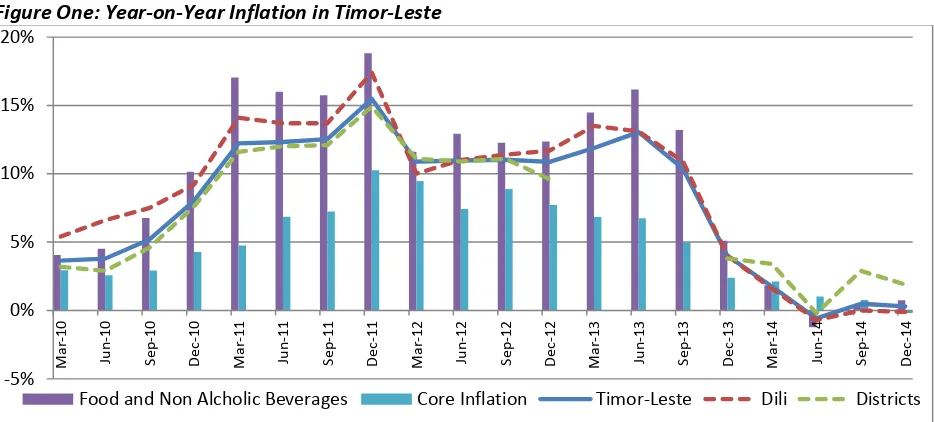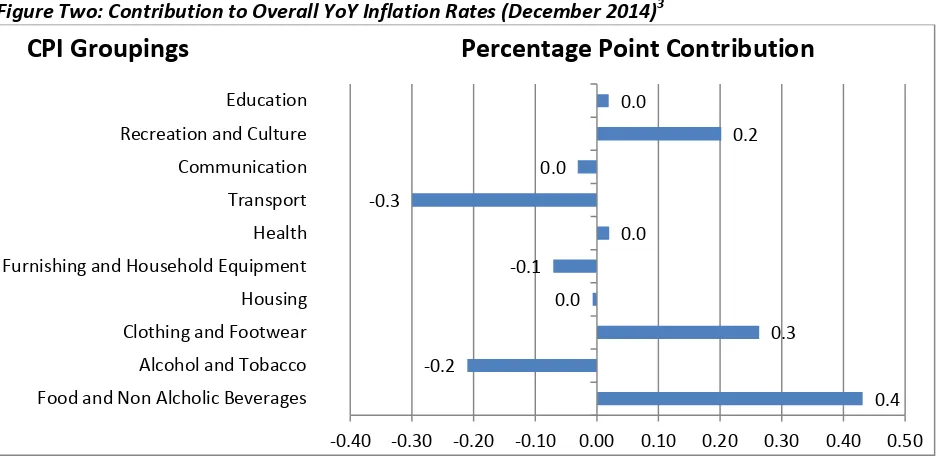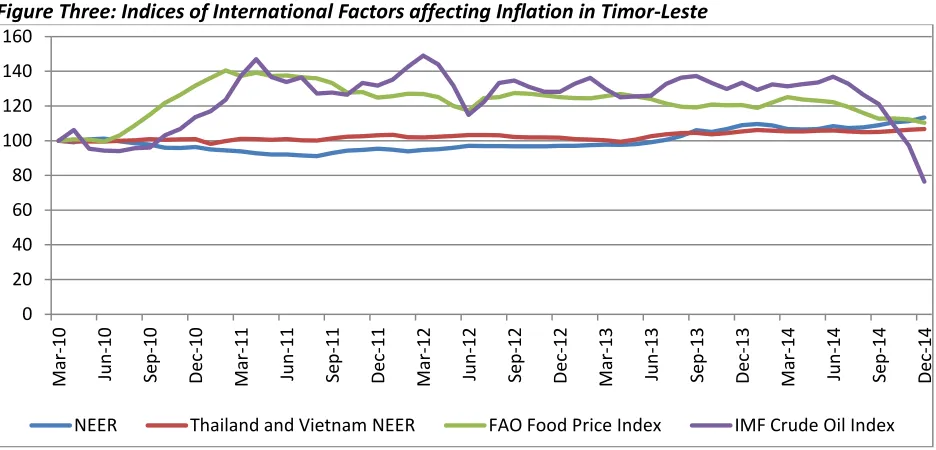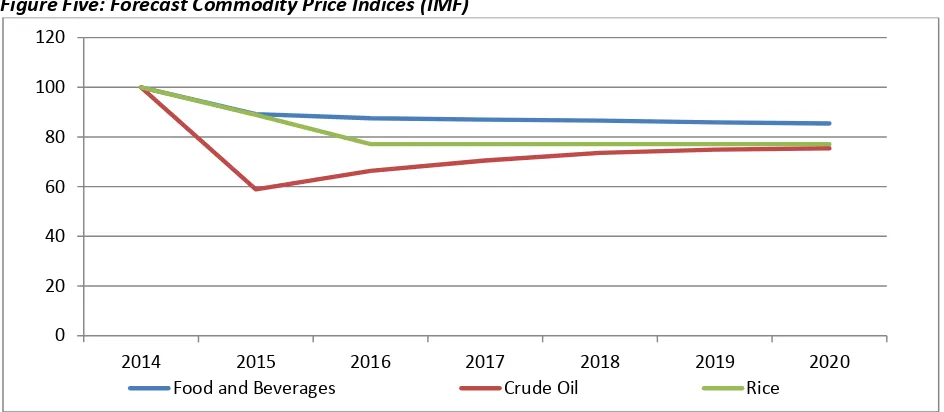1
QUA RT E R LY I N F L AT I O N
R E V I E W
OCTOBER - D ECEMBER 2014
n.12EXECUTIVE SUM MARY
In December 2014 year-on-year (YoY) inflation in Timor-Leste was 0.3%, this rate is below the 4%-6% target ra ge set out i the Go er e t’s Strategi De elop e t Pla SDP . YoY inflation is now significantly lower than the 4.0% rate seen in December 2013 and marginally down on the rate of 0.5% in September 2014. Quarter-on-quarter (QoQ) inflation in December 2014 was 0.4%; this is slightly lower than the rates of 0.6% and 0.5% seen in December 2013 and September 2014.
The low YoY inflation in Timor-Leste can mainly be attributed to international factors such as:
The appreciation of the US dollar against the majority of Timor-Leste’s tradi g part er’s currencies
The significant decrease in the international price of oil
The decrease in international food prices
TREN DS I N I N FL ATION
In December 2014 YoY inflation in Timor-Leste was 0.3%; this means that a basket of goods and services that cost $100.00 in December 2013 will now cost $100.30 in December 2014. YoY inflation is now significantly lower than the 4.0% rate seen in December 2013, but remains similar to the rate of 0.5% seen in September 2014. QoQ inflation in December 2014 was 0.4%; marginally down on the rates of 0.6% and 0.5% seen in December 2013 and September 2014 respectively.
After a lengthy period of double-digit inflation between March 2011 and September 2013, inflation de reased dra ati all a d fell elo the Go er e t’s %-6% target range in January 2014. In recent months YoY inflation appears to have stabilized at around 0.0% - 0.5%.
2
The double digit YoY inflation between March 2011 and September 2013 was largely driven by increases in food and non-alcoholic beverages inflation (see Figure One). Food and non-alcoholic beverages account for approximately 64% of Timor-Leste’s CPI asket1, as nearly two thirds of Timorese household expenditure is spent on this group. Thus price movements in this group will have a significant impact on the overall rate of inflation and the purchasing power of the Timorese citizens. YoY food and non-alcoholic beverage inflation in December 2014 was 0.8%, down from 5.1% in December 2013.
Core inflation, which excludes the prices of particularly volatile items, was -0.2% in December 2014, down from 0.8% in September 2014. Core inflation may provide a more accurate measure of long-term inflationary trends as it is less susceptible to being impacted by temporary price shocks.
Figure One: Year-on-Year Inflation in Timor-Leste
Over the past 12 months there have been significant price changes in the following expenditure classes2:
Milk, cheese and eggs (8.8%)
Mineral waters, soft drinks and fruit and vegetable drinks (-13.2%)
Recreation and Culture (6.6%)
Transport (-4.9%)
The largest upwards contributions (see Figure Two) to the overall year-on-year inflation rate in December 2014 came from:
Food and non-alcoholic (0.4 percentage points)
Recreation and culture (0.2pp)
Clothing and Footwear (0.3pp)
While the largest deflationary contributions (see Figure Two) to the overall year-on-year inflation rate in December 2014 came from:
Expenditure classes are the sub-categories within an expenditure group in a CPI index -5%
3
Alcohol and Tobacco (-0.2pp)
Figure Two: Contribution to Overall YoY Inflation Rates (December 2014)3
CAU SES O F I N FL ATION
4 movement over the September 2013 to September 2014 period is analyzed.Between September 2013 and September 2014 Timor-Leste’s nominal effective exchange rate (NEER) appreciated by 2.7%, this appreciation was largely driven by the 5.4% appreciation of the US dollar against the Indonesian rupiah, the currency of Timor-Leste’s largest tradi g part er6. Over this period the US dollar also appreciated against by 0.5% against a weighted Thai baht and Vietnamese dong basket. This appreciation is likely to have placed downward pressure on rice prices (as these countries export large quantities of rice to Timor-Leste) and therefore inflation, as rice has a large weight in the CPI index.
3
See concepts and terminology section for further explanation 4
Within this section inflation refers to YoY inflation 5
This analysis lags the impact by one quarter 6
External Trade Statistics Annual Report 2013, General Directorate of Statistics
4
I ter atio al oil pri es also fell o er the Septe er to Septe er period, the IMF’s rude petroleum price index fell7 by 11.8% over the period placing further downward pressure on inflation. International food prices also fell over the period with the Food and Agricultural Organizatio ’s FAO food price index falling by 5.4% placing further downward pressure on imported food prices.
Figure Three: Indices of International Factors affecting Inflation in Timor-Leste
Domestic Factors
It is possible that increases in Government expenditure, particularly recurrent expenditures such as transfers and salaries & wages, have increased inflationary pressure in Timor-Leste. Recurrent Government expenditure between Q4 2013 and Q4 2014 have been higher than in the same period in the previous year (see Figure Four).
Figure Four: Year-on-Year Nominal Growth in Quarterly Recurrent and Total Expenditure (%)
7
The crude oil (petroleum) price index is a simple average of three spot prices; Dated Brent, West Texas Intermediate, and the Dubai Fateh.
NEER Thailand and Vietnam NEER FAO Food Price Index IMF Crude Oil Index
-80%
5
This seems at odds with the observed low inflation; however there are several possible explanations for this:
The favourable international conditions, as discussed above, may outweigh the domestic inflationary pressure coming from Government expenditure.
The inflationary impact of Government expenditure may not be felt until several periods after it occurs as it takes time for prices to adjust to the increase in demand.
Downward inflationary pressure may be coming from other domestic factors on both the supply and demand side such as increases agricultural production, improvements in absorptive
capacity8 and decreased non-Government aggregate demand.
The lower rate of expenditure growth seen in Q4 2014 and the controlled recurrent expenditure growth pla ed i the State Budget for de o strates the Go er e t’s o it e t its i flatio target.
CON SEQ UE NCES OF IN FL ATIO N
Inflation will cause households’ purchasing power to fall, if increases in household income are lower than the increases in inflation. This situation is more likely to occur in a high inflation environment. Inflation which reduces consumers’ purchasing power can reduce living standards and may increase poverty. Thus the recent low inflation seen in Timor-Leste is o siste t ith the Go er e t’s po ert reduction strategy.
If inflation is higher in Timor-Leste than in its trading partners Timor-Leste will become less competitive leading to a fall in export demand. Thus the recent low inflation environment is likely to have helped increase demand for Timorese exports.
IN FL ATIO N OUT L OOK
YoY inflation is likely to remain below the SDP target range in the near term. The following factors are likely to have impact future rates of inflation in Timor-Leste:
International commodity prices:
between September 2014 and December 2014 there were falls in both international food (-2.1%) and crude oil (-36.9%) prices. The fall was largely driven by excess supply resulti g fro Saudi Ara ia’s de isio to ai tai high produ tio despite of i reased glo al suppl . As changes in commodity prices have a lagged affect on inflation in Timor-Leste it is likely that this will place downward inflationary pressure in Q1 2015. In the medium to long-term the low forecasted9 commodity prices will help to keep inflation low in Timor-Leste.International exchange rates: between September 2014 and December 2014 the 4.1% appreciation of Timor-Leste’s NEER will put downward pressure on inflation by reducing the cost of imported goods and services.
8
The amount of money that can be spent in an economy before inflation begins to increase 9
6
Government expenditure: the increase in Government expenditure over the last four quarters will result in increased inflationary pressure, the extent to which this will result in higher inflation depends on the impact of other factors and the economies absorptive capacity.
Figure Five: Forecast Commodity Price Indices (IMF)
0 20 40 60 80 100 120
2014 2015 2016 2017 2018 2019 2020
7
ANN EX: C O NCE P TS AN D T ERMIN O L OGY
Consumer price inflation the rate at which the prices of goods and services bought by households increase or decrease.
The Consumer Price Index (CPI)10isused to measure consumer price inflation. To understand CPI think of a large basket containing the goods and services bought by households, the CPI estimates the change to the total cost of the basket on a monthly basis.
Year-on-year (YoY) inflation is the most commonly used measure and is calculated by comparing the price index from a given period with the same month in the previous year. For example, the year-on-year inflation in December 2014 measures the percentage change in prices between December 2013 and December 2014.
Quarter-on-quarter inflation (QoQ) is calculated by comparing the price index from the last month of a given quarter (March, June, September or December) with the last month of the previous quarter11. Thus quarter-on-quarter inflation in December2014 measures the percentage change in prices between September 2014 and December 2014.
Month-on-month inflation (MoM) is calculated by comparing the price index from the latest month to the previous month. Thus the month-on-month inflation in December2014 measures the percentage change in prices between November 2014 and December 2014.
Contribution to inflation rate measures the contribution to the overall rate of inflation of a grouping of goods and services, a groups contribution to the overall rate of inflation is determined by its growth rate and weight within the series12.
Nominal effective exchange rate (NEER) is the eighted a erage alue of a ou tr ’s urre relati e
to the currencies of its major trading partners
Core inflation is a measure of inflation which excludes certain items that face volatile price movements. Core inflation eliminates products13 that can have temporary price shocks because these shocks can cause a divergence from the overall trend in inflation giving a false measure of inflation.
Purchasing Power measures the quantity of goods and services which can be purchased with a unit of currency. All else being equal inflation decreases the amount of goods and services a consumer is able to purchase with their monthly salary.
Timor-Leste’s Co su er Pri e I de is pu lished o thl Ge eral Dire torate of Statisti s MoF14. This index is divided into 10 specific groups representing specific sets of commodities such as food and non-alcoholic beverages, housing and transport. In addition, separate consumer price indices are compiled for both Dili and the districts.
10
The CPI is a weighted index meaning that the influence on the CPI index of a given item is dependent on the
ite ’s share i total household o su ptio .
11
In this publication 12
The contributions of each grouping will sum to give the overall rate of inflation 13
The core inflation index in Timor-Leste excludes all food and non-alcoholic beverage items 14



